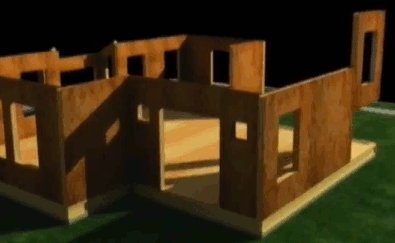
Structural Insulated Panels (SIPs) provide wall, roof and floor framing, insulation and sheathing. Homes can be erected in few days, with minimal equipment and site work.
 SIP Panels Construction: Like Large Lego Blocks
SIP Panels Construction: Like Large Lego Blocks It's easy to build with SIPs. It’s a bit like building the home’s walls (and floors and roofs) with large Lego blocks. But its effectiveness depends largely on a set of details, involving the sealing of joints and voids or the flashing of the windows, doors, chimneys, etc.
The panels should not contact directly the ground and concrete, and should be protected from pests and, above all, from humidity and water.
 SIPs Energy Efficiency
SIPs Energy EfficiencySelect SIPs with a thick enough insulation core (take into account your climate). Wall insulation is extremely important for home comfort and energy performance.
SIP insulation and energy performance varies with the type of material and its thickness, as shown in the table at right with data from SIPA.
 Pay Attention to Moisture problems
Pay Attention to Moisture problemsSIPs are around since the 70s. So far so good, but we don't know for sure how many decades their adhesive bonds, or their OSB and their foams will last...
SIPs can provide an affordable energy-efficient building.
But be aware to moisture problems. SIPs have to be carefully protected from moisture. Sealing, flashing and siding are very important to prevent the panels from being damaged.
See:
Insulated Panels Moisture and Cares
SIPs Pros and Cons
 Less or More Expensive to Build?
Less or More Expensive to Build? SIPs allow for significant savings in labor costs; and standard panels with standard materials can be less expensive than conventional wood-frame alternatives.
See: SIPs prices
 Types of SIPs
Types of SIPsSIPs come in typical 4 feet wide panels with a thick core of expanded polystyrene (EPS) or extruded polystyrene (XPS). But their core can be made from other insulation materials: polyisocyanurate, urethane, polyurethane and also compressed straw and mineral wool…
Their thickness - and their insulation value - varies a lot. Your home's energy-efficiency and comfort, and your heating and cooling bills, will depend on it.
Pay also attention to the type of adhesives (bonding the core of the panel to its boards) and the materials that make the boards (OSB, fiber-cement...).
See: SIP Types
 SIPs Manufacturers and Contractors
SIPs Manufacturers and ContractorsThere are dozens of SIP manufacturers, but they may be distant of your home, and contractors with the necessary know-how may be difficult to find.
Though growing at a fast rate, and relatively common in some European and North-American regions, SIP construction represents only about 1% of the new home construction market.
See: SIP Manufacturers and Contractors